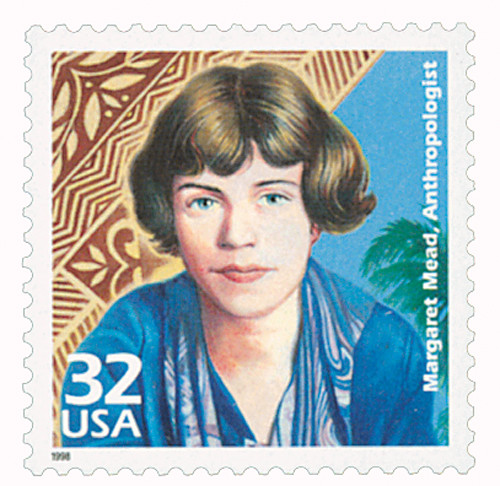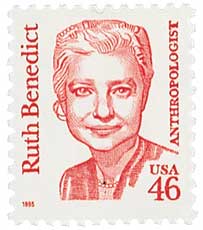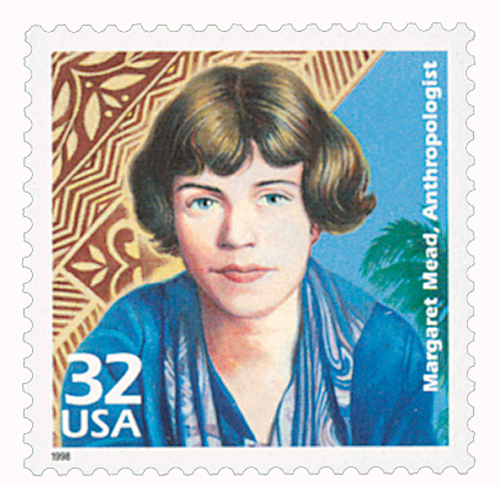
# 3184g FDC - 1998 32c Celebrate the Century - 1920s: Margaret Mead
32¢ Margaret Mead
Celebrate the Century – 1920s
City: Washington, DC
Quantity: 12,533,000
Printed By: Ashton-Potter (USA) Ltd
Printing Method: Lithographed
Perforations: 11.5
Color: Multicolored
Happy Birthday To Margaret Mead
The oldest of five children, Mead was raised to be a social scientist. At the age of eight, she was assigned to observe and record her sister’s speech patterns. Mead’s family moved a lot when she was young, so her grandmother taught her until she was 11. Mead spent a year at DePauw University before transferring to Barnard College, where she studied anthropology.

After graduating in 1923, Mead studied under Franz Boas and Ruth Benedict at Columbia University. She earned her master’s the following year and then went to American Samoa to conduct fieldwork. Mead was made an assistant curator at the American Museum of Natural History in 1926 and then earned her PhD from Columbia in 1929. She then went on to become director of research in contemporary cultures, and eventually adjunct professor of anthropology at Columbia.
Known for her study of controversial social topics and her plain English style of writing, Mead soon endeared herself to up-and-coming anthropology students. Many of her studies dealt with the different child-rearing patterns of other cultures. At the beginning of her career in 1925, Mead spent several months in Samoa studying the lives of adolescent girls in three coastal villages. She then compared the experiences of these girls with those of American girls in the book Coming of Age in Samoa, possibly her most famous work.

Although Coming of Age in Samoa was one of Mead’s most famous studies, she was the author of several other books. Some of her other well-known works include Growing Up in New Guinea, Male and Female, and Soviet Attitudes Toward Authority. The final study she published actually chronicled her own aging process.

Outside of her research, Mead served as executive secretary of the National Research Council’s Committee on Food Habits during World War II. She was also elected a fellow of the American Academy of Arts and Sciences and taught at several other colleges. Mead later served as president of the Society for Applied Anthropology and the American Anthropological Association.

In the 1960s, she helped establish Glyphs, Inc., which sought to create a universal language of graphic symbols that could be understood by people from any culture. In the 1970s, Mead was president and served on the board of directors of the American Association for the Advancement of Science. She’s been credited with coining the term semiotics (the study of sign processes). Mead also participated in the United Nations Habitat I, that organization’s first forum on human settlements.
Mead suffered from pancreatic cancer and died on November 15, 1978. The following year, she was posthumously awarded the Presidential Medal of Freedom.
32¢ Margaret Mead
Celebrate the Century – 1920s
City: Washington, DC
Quantity: 12,533,000
Printed By: Ashton-Potter (USA) Ltd
Printing Method: Lithographed
Perforations: 11.5
Color: Multicolored
Happy Birthday To Margaret Mead
The oldest of five children, Mead was raised to be a social scientist. At the age of eight, she was assigned to observe and record her sister’s speech patterns. Mead’s family moved a lot when she was young, so her grandmother taught her until she was 11. Mead spent a year at DePauw University before transferring to Barnard College, where she studied anthropology.

After graduating in 1923, Mead studied under Franz Boas and Ruth Benedict at Columbia University. She earned her master’s the following year and then went to American Samoa to conduct fieldwork. Mead was made an assistant curator at the American Museum of Natural History in 1926 and then earned her PhD from Columbia in 1929. She then went on to become director of research in contemporary cultures, and eventually adjunct professor of anthropology at Columbia.
Known for her study of controversial social topics and her plain English style of writing, Mead soon endeared herself to up-and-coming anthropology students. Many of her studies dealt with the different child-rearing patterns of other cultures. At the beginning of her career in 1925, Mead spent several months in Samoa studying the lives of adolescent girls in three coastal villages. She then compared the experiences of these girls with those of American girls in the book Coming of Age in Samoa, possibly her most famous work.

Although Coming of Age in Samoa was one of Mead’s most famous studies, she was the author of several other books. Some of her other well-known works include Growing Up in New Guinea, Male and Female, and Soviet Attitudes Toward Authority. The final study she published actually chronicled her own aging process.

Outside of her research, Mead served as executive secretary of the National Research Council’s Committee on Food Habits during World War II. She was also elected a fellow of the American Academy of Arts and Sciences and taught at several other colleges. Mead later served as president of the Society for Applied Anthropology and the American Anthropological Association.

In the 1960s, she helped establish Glyphs, Inc., which sought to create a universal language of graphic symbols that could be understood by people from any culture. In the 1970s, Mead was president and served on the board of directors of the American Association for the Advancement of Science. She’s been credited with coining the term semiotics (the study of sign processes). Mead also participated in the United Nations Habitat I, that organization’s first forum on human settlements.
Mead suffered from pancreatic cancer and died on November 15, 1978. The following year, she was posthumously awarded the Presidential Medal of Freedom.













